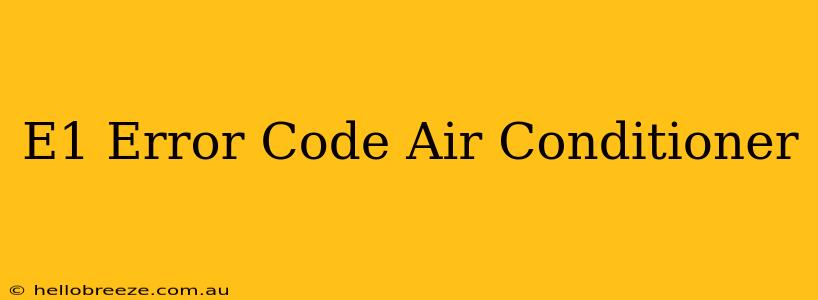Is your air conditioner displaying an E1 error code? This frustrating situation leaves you sweating in the heat, but don't panic! This comprehensive guide will help you understand the meaning of the E1 error code, troubleshoot the problem, and potentially solve it yourself. We'll cover common causes, preventative measures, and when it's time to call a professional.
Understanding the E1 Error Code
The dreaded E1 error code varies slightly depending on your air conditioner's brand and model. However, in most cases, it points to a problem with the indoor unit's evaporator coil. This coil is responsible for absorbing heat from the air inside your home, crucial for effective cooling. The error code essentially signals a malfunction related to this component.
Common Causes of the E1 Error Code
Several issues can trigger the E1 error code, including:
- Frozen Evaporator Coil: This is one of the most frequent culprits. Ice buildup restricts airflow, hindering the coil's ability to absorb heat and ultimately leading to the error code. This freezing often results from:
- Restricted Airflow: Dirty air filters, clogged vents, or obstructions near the unit prevent proper airflow, causing the coil to freeze.
- Low Refrigerant: Insufficient refrigerant reduces the coil's cooling capacity, resulting in freezing. A leak in the system is often the root cause of low refrigerant.
- Faulty Fan Motor: A malfunctioning fan motor prevents adequate airflow across the evaporator coil.
- Faulty Evaporator Coil: In some cases, the coil itself might be damaged or inefficient, causing the freezing problem and triggering the E1 code.
- Control Board Issues: While less common, a problem with the air conditioner's control board can also lead to an E1 error. The control board manages various functions, and a malfunction can lead to inaccurate readings or incorrect operation.
- Sensor Problems: Incorrect readings from temperature or other sensors can cause the system to misread conditions and trigger the E1 error.
Troubleshooting the E1 Error Code: A Step-by-Step Guide
Before you call an expensive repair technician, try these troubleshooting steps:
1. Check the Air Filter: A clogged air filter is the most common cause of restricted airflow and freezing. Locate your air filter (usually in the return air vent) and replace it with a clean one. This simple step often resolves the issue.
2. Inspect for Obstructions: Carefully examine the vents and areas around the indoor unit. Ensure there are no obstructions blocking airflow, such as furniture, curtains, or debris.
3. Check the Fan Motor: Listen carefully for the fan motor's operation. If it's not running or running weakly, this could be a sign of a faulty motor requiring professional attention.
4. Allow the Coil to Thaw: If the coil is frozen, turn off the air conditioner and allow it to thaw completely. This may take several hours. Do not attempt to force-thaw the coil with a heater or other heat source; you risk damaging the unit.
5. Restart the Air Conditioner: Once the coil has completely thawed and the air filter is clean, try restarting your air conditioner. Hopefully, the E1 error code will disappear.
When to Call a Professional
If the E1 error code persists after trying the troubleshooting steps above, it's best to contact a qualified HVAC technician. Issues like refrigerant leaks, faulty coils, or control board problems require specialized knowledge and equipment to diagnose and repair. Attempting to repair these issues yourself could void your warranty or potentially damage your air conditioner further.
Preventative Maintenance: Avoiding Future E1 Errors
Regular maintenance significantly reduces the risk of encountering the E1 error code and other air conditioner problems:
- Change Air Filters Regularly: This is the single most important preventative measure. Replace filters every 1-3 months, or more frequently if you have pets or allergies.
- Schedule Annual Maintenance: A professional HVAC technician can inspect your system for potential problems, clean components, and ensure optimal performance, preventing costly repairs down the line.
- Keep the Area Around the Unit Clear: Ensure proper airflow by keeping the area around your indoor unit free of obstructions.
By following these tips, you can better understand the E1 error code, effectively troubleshoot potential problems, and maintain the optimal performance of your air conditioner, keeping you cool and comfortable all summer long. Remember, prevention is key!

